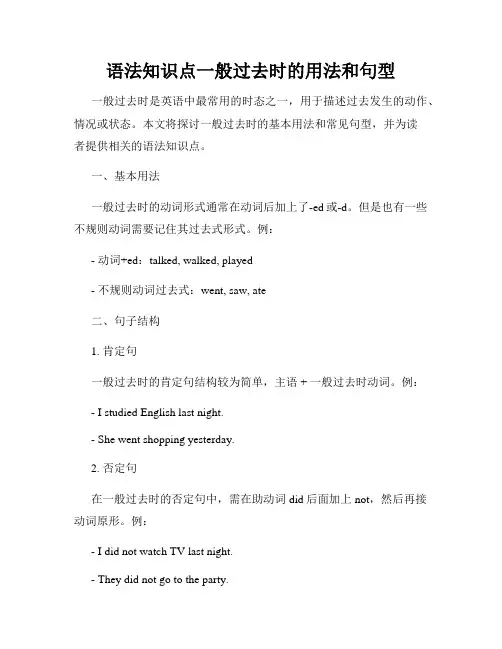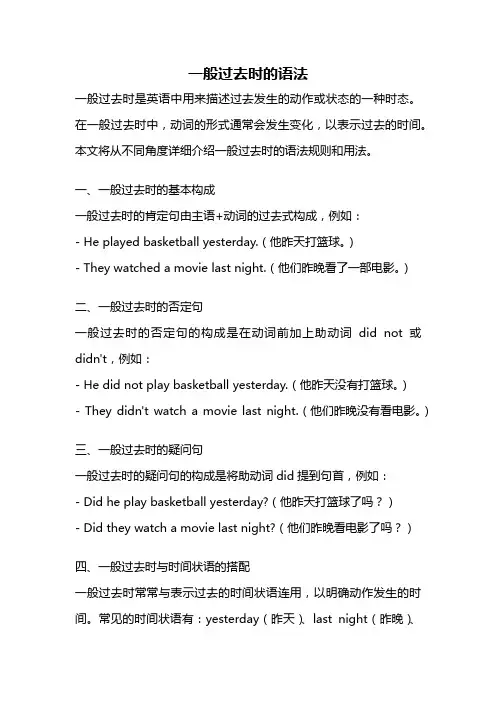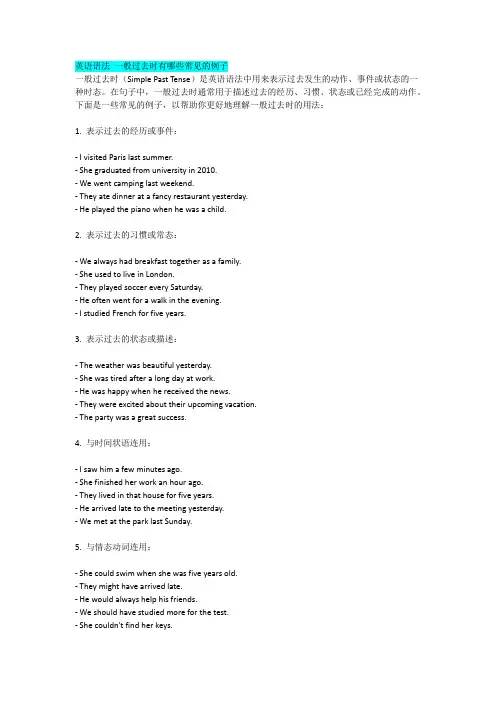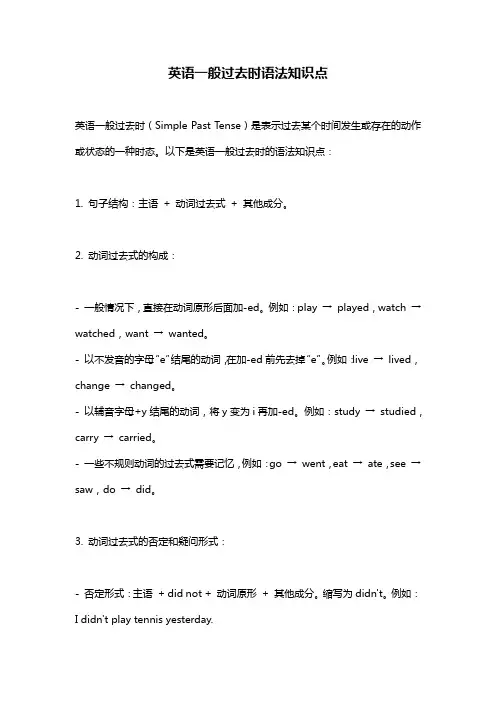英语语法之一般过去时
一般过去时.语法讲解PPT

一般过去时常用的时间状语包括过去的时间点、过去的时间段 等,而过去完成时常用的时间状语包括“已经”、“之前”等
。
05
一般过去时的练习与巩固
填空练习
总结词
填空练习是巩固一般过去时的有效方法,通过在句子中留空,让学生填写正确的动词时态,加深对一般过去时的 理解和运用。
详细描述
在填空练习中,教师可以选择一些包含一般过去时的句子,故意去掉动词时态部分,让学生根据上下文语境和时 态规则填写正确的时态。例如,“Yesterday, I ____(go) to the park with my family. We ____ (have) a great time.” 学生应该填写“went”和“had”。
表示过去的习惯或经常发生的动作
描述过去的习惯
一般过去时可以用来描述过去经常发 生的动作或习惯,例如“He used to smoke a pack of cigarettes a day” (他以前每天抽一包烟)。
描述过去的频率
一般过去时可以用来表示过去某个时间 段内发生的动作的频率,例如“We met every week”(我们每周见面一 次)。
一般过去时表示动作已经完成,而过去进行时则表示动作正在进行中。
总结词
时间状语不同
详细描述
一般过去时常用的时间状语包括过去的时间点、过去的时间段等,而 过去进行时常用的时间状语包括“当时”、“正在”等。
与过去完成时混淆的用法
总结词 详细描述
总结词 详细描述
动作是否完成
一般过去时表示动作已经完成,而过去完成时则表示在过去的 某个时间点之前已经完成的动作。
选择练习
总结词
选择练习是一种常见的练习方式,通过提供多个选项,让学生选择符合语境和语法规则的答案,进一 步巩固一般过去时的运用。
语法知识点一般过去时的用法和句型

语法知识点一般过去时的用法和句型一般过去时是英语中最常用的时态之一,用于描述过去发生的动作、情况或状态。
本文将探讨一般过去时的基本用法和常见句型,并为读者提供相关的语法知识点。
一、基本用法一般过去时的动词形式通常在动词后加上了-ed或-d。
但是也有一些不规则动词需要记住其过去式形式。
例:- 动词+ed:talked, walked, played- 不规则动词过去式:went, saw, ate二、句子结构1. 肯定句一般过去时的肯定句结构较为简单,主语 + 一般过去时动词。
例:- I studied English last night.- She went shopping yesterday.2. 否定句在一般过去时的否定句中,需在助动词did后面加上not,然后再接动词原形。
例:- I did not watch TV last night.- They did not go to the party.3. 一般疑问句一般过去时的一般疑问句需要将助动词did放在句首,然后将主语放在did后面,接原形动词。
例:- Did you finish your homework yesterday?- Did they visit their grandparents last weekend?三、时间状语一般过去时常与表示过去时间的状语连用,以明确动作或状态发生的时间。
以下是一些常用的时间状语:- yesterday- last week/month/year- in 1990- a few days ago- when I was a child- at that time- in the past四、陈述句和疑问句的回答在陈述句中,我们通常用完整的句子回答,而在疑问句中,我们可以用简略回答或完整回答。
例:- Did you go to the party? - Yes, I did. / No, I didn't.- Did he finish his homework? - Yes, he did. / No, he didn't.五、经常与一般过去时连用的词汇1. 过去连续性的动作:- was/were + 动词-ing:I was playing basketball when she called me. - used to + 动词原形:I used to walk to school when I was young.2. 时间副词:- ago:He moved to New York two years ago.- before:I had never seen such a beautiful scenery before.- when:I was reading a book when the phone rang.3. 愿望:- wish + 一般过去时:I wish I knew the answer.六、一般过去时的注意事项1. 与现在的区别:一般过去时描述过去的动作、情况或状态,与现在时相对应。
一般过去时的语法

一般过去时的语法一般过去时是英语中用来描述过去发生的动作或状态的一种时态。
在一般过去时中,动词的形式通常会发生变化,以表示过去的时间。
本文将从不同角度详细介绍一般过去时的语法规则和用法。
一、一般过去时的基本构成一般过去时的肯定句由主语+动词的过去式构成,例如:- He played basketball yesterday.(他昨天打篮球。
)- They watched a movie last night.(他们昨晚看了一部电影。
)二、一般过去时的否定句一般过去时的否定句的构成是在动词前加上助动词did not或didn't,例如:- He did not play basketball yesterday.(他昨天没有打篮球。
)- They didn't watch a movie last night.(他们昨晚没有看电影。
)三、一般过去时的疑问句一般过去时的疑问句的构成是将助动词did提到句首,例如:- Did he play basketball yesterday?(他昨天打篮球了吗?)- Did they watch a movie last night?(他们昨晚看电影了吗?)四、一般过去时与时间状语的搭配一般过去时常常与表示过去的时间状语连用,以明确动作发生的时间。
常见的时间状语有:yesterday(昨天)、last night(昨晚)、last week(上周)、in 2010(在2010年)等等。
五、一般过去时的用法1. 表示过去发生的动作或状态She lived in New York for five years.(她在纽约住了五年。
)2. 表示过去经常或反复发生的动作He often went swimming when he was young.(他年轻时经常去游泳。
)3. 表示过去的习惯或常态She always cooked dinner for her family.(她过去总是为家人做晚饭。
英语语法 一般过去时有哪些常见的例子

英语语法一般过去时有哪些常见的例子一般过去时(Simple Past Tense)是英语语法中用来表示过去发生的动作、事件或状态的一种时态。
在句子中,一般过去时通常用于描述过去的经历、习惯、状态或已经完成的动作。
下面是一些常见的例子,以帮助你更好地理解一般过去时的用法:1. 表示过去的经历或事件:- I visited Paris last summer.- She graduated from university in 2010.- We went camping last weekend.- They ate dinner at a fancy restaurant yesterday.- He played the piano when he was a child.2. 表示过去的习惯或常态:- We always had breakfast together as a family.- She used to live in London.- They played soccer every Saturday.- He often went for a walk in the evening.- I studied French for five years.3. 表示过去的状态或描述:- The weather was beautiful yesterday.- She was tired after a long day at work.- He was happy when he received the news.- They were excited about their upcoming vacation.- The party was a great success.4. 与时间状语连用:- I saw him a few minutes ago.- She finished her work an hour ago.- They lived in that house for five years.- He arrived late to the meeting yesterday.- We met at the park last Sunday.5. 与情态动词连用:- She could swim when she was five years old.- They might have arrived late.- He would always help his friends.- We should have studied more for the test.- She couldn't find her keys.6. 否定句和疑问句:- I did not go to the party.- Did she see the movie?- They didn't finish their homework on time.- Was he at home yesterday?- Did you have a good time at the concert?7. 连词连用:- When I was a child, I loved playing outside.- While they were cooking, I set the table.- As I walked down the street, I saw an old friend.这些例子涵盖了一般过去时在不同语境下的应用。
英语一般过去时语法知识点

英语一般过去时语法知识点英语一般过去时(Simple Past Tense)是表示过去某个时间发生或存在的动作或状态的一种时态。
以下是英语一般过去时的语法知识点:1. 句子结构:主语+ 动词过去式+ 其他成分。
2. 动词过去式的构成:- 一般情况下,直接在动词原形后面加-ed。
例如:play →played,watch →watched,want →wanted。
- 以不发音的字母“e”结尾的动词,在加-ed前先去掉“e”。
例如:live →lived,change →changed。
- 以辅音字母+y结尾的动词,将y变为i再加-ed。
例如:study →studied,carry →carried。
- 一些不规则动词的过去式需要记忆,例如:go →went,eat →ate,see →saw,do →did。
3. 动词过去式的否定和疑问形式:- 否定形式:主语+ did not + 动词原形+ 其他成分。
缩写为didn't。
例如:I didn't play tennis yesterday.- 疑问形式:Did + 主语+ 动词原形+ 其他成分例如:Did you watch the movie last night?4. 一般过去时的时间状语:昨天(yesterday)、上个月(last month)、去年(last year)等表示过去某个具体时间的时间状语。
5. 一般过去时的用法:- 表示过去某个具体时间发生的动作或状态。
例如:I went to the beach yesterday.- 表示过去一段时间内发生的动作或状态。
例如:I lived in London for two years.- 表示过去习惯性的动作或状态。
例如:When I was a child, I always played with my friends.以上就是英语一般过去时的语法知识点。
记得多加练习,熟练掌握一般过去时的用法。
初中英语语法-八大时态之一般过去时课件全文

一般过去时疑问句
对于含有是实意动词的句子, 一般疑问句: Did +主语+动词其他…? 特殊疑问句:疑问词+ did(didn’t)+主语+其它? What did you do yesterday? Why did you go there the day before yesterday? Whose father came to see our teacher just now?
Theyw_e_r_e from Japan. I _w_a_s very tired.
4. He is too young to go to school.
Hew_a_s_too young to go to school.
5. You are late for school. Youw_e_r_e late for school.
一般过去时-不含有be动词型
把句子中的动词改为过去式形式。
通常有5种写法。
动词过去式的写法:
01 一般情况词尾加ed 02 e结尾直接在词尾加d 03 辅音加y结尾变y为i加ed 04 重读闭音节结尾双写词尾字母加ed 05 特殊情况
I work in this city. I worked in this city last year.
We are friends.
We weren't friends.
2.当谓语动词是实意动词时,它 与助动词did有关
主语+did + not+ 动词
动词谓语一定要恢复为原形。
一般过去时否定式
主语+did + not+ 动词原型
英语一般过去时语法知识讲解
英语一般过去时语法知识讲解一般过去时表示过去某个时间里发生的动作或状态;过去习惯性、经常性的动作、行为;过去主语所具备的能力和性格。
下面小编给大家分享了有关一般过去时的英语语法知识,一起来看看吧!一般过去时的结构一、构成方法一般过去时用动词的过去式构成,即在动词原形后加ed。
二、用法说明1、表示在过去某个时间所发生的动作或所处的状态。
常与yesterday, last week, in 1989, just now, a moment ago, the other day等连用。
如:He was here just now. 他刚才还在这里。
What did you do yesterday? 你昨天做了什么事?2、在过去一段时间内的经常性或习惯性动作。
如:We often played together when we were children. 我们小时候常在一起玩。
注:表示过去经常发生的动作还可用used to 和would。
如:He used to smoke a lot, but he doesn't now. 他过去经常抽烟,但现在不抽了。
Whenever we were in trouble, he would help us. 每当我们遇到困难,他都会帮助我们。
3、表示主语过去的特征或性格。
如:At that time she was very good at English. 那时她英语学得很好。
4、用在状语从句中表示过去将来。
如:He said he would wait until they came back.5、一般过去时有时可以表示现在,多与want, hope, wonder, think, intend 等动词连用,使语气更委婉。
如:I wondered if you could help me. 不知你能不能帮我一下。
6、有时用一般过去时也是时态一致的需要。
时态—一般过去时(英语语法课件)
灵活运用
Dear Sir,
Our weekend at your hotel was bad. Our room was big but everything was very old. Our friend Robin cleaned our room and fixed a broken chair. My mother wanted to read a book but the lamp was too small.My dad got some hamburgers from the hotel kitchen, but they were cold and tasted bad. I wanted to watch TV but the TV didn't work. The people in Room 301 listened to loud music. I didn't sleep all night. I'm sorry, but we didn't enjoy our stay very much.
要点呈现
am-was run-ran
go-went study-studied play-played
Simple past tense-- to describe the things happened in the past; to describe the things we usually do in the past.
表示过去的词及表达 1. yesterday, ago, the day before yesterday 2.一段时间+ ago an hour ago, ten minutes ago st +时间词 last week, last year, last month 4.一个过去的时间 when he was five years old,just now 5.特殊词汇 on用在特定句型中表示现在时间和将来时间, 表示婉转语气或设想。 eg. 1. I wondered if you could give me some help. 2. It’s time you had a holiday.
英语语法之一般过去时
一般过去时的特殊疑问句的构成:“疑 问词+did+主语+动词原形+其它”? 实际上也是“疑问词+一般疑问句”如: 1) - Where did you go last night? -I did my homework. 2) - What did you dolast week? -I went to Shanghai with my parents.
1一般过去时的一般疑问句的构成:Did+
主语+动词原形+其它?如: 1) - Did you go to Beijing last week? -Yes, we did. (No, we didn't.) 2) - Did you meet the businessman before? -No, I didn't. (Yes, I did.)
1四、A—A—B型,即过去式和原形相同。
(1个) beat—beat—beaten 打 五、A—B—A型,即过去分词和原形相同。 (3个) come—came—come 来become— became—become变成run— ran—run 跑 六、情态动词型,只有原形和过去式, 没有过去分词。(4个)can—could 能 may—might 可以will—would 将要shall— should可以
93个不规则动词: 一、A—A—A型,即原形、过去式和过去 分词三者都相同。(共9个) cost—cost— cost 花费cut—cut—cut 剪切hit—hit—hit 碰hurt—hurt—hurt伤害 let—let— let 让 put—put—put 放read—read—read读 set—set—set 设置shut—shut—shut关闭 二、A—B—B型,即过去式、过去分词相 同。(共41个) 1过去式和过去分词都含 有 -ought。(3个) bring—brought— brought 带着buy— bought—bought买 think—thought—thought 思考
英语学习:一般过去时语法解释大全
英语学习:一般过去时语法解释大全一、基本概念一般过去时是英语中的一种基本时态,表示在过去某个时间发生的动作或状态。
它常用于描述已经发生的事情,特别强调该动作或状态与现在没有直接联系。
二、动词变化1. 规则动词:大多数动词的过去式形式是在动词后面加上-ed。
例如:work-worked, write-wrote。
2. 不规则动词:一些动词的过去式形式与其他动词不同。
例如:be-was/were, have-had, do-did。
3. 特殊情况:有些动词的过去式形式与动词原形相同,如:go-went, see-saw。
三、时间状语一般过去时通常与表示过去的时间状语一起使用,如:yesterday, last night, three days ago等。
四、与其他时态比较1. 现在完成时vs 一般过去时:现在完成时强调动作对现在的影响或结果,而一般过去时只关注过去的动作或状态。
例如:“I have seen the movie”(我已经看过这部电影)应该使用现在完成时,而不是一般过去时。
2. 一般现在时vs 一般过去时:一般现在时描述现在的状态或习惯,而一般过去时描述过去的状态或习惯。
例如:“I usually watch TV at night”(我通常在晚上看电视)应该使用一般现在时,而不是一般过去时。
五、特殊用法1. 表达过去的经验:例如:“I visited Paris last year”(我去年参观了巴黎)。
2. 表达假设条件:例如:“If I were you, I would do it”(如果我是你,我会去做这件事)。
六、与过去进行时的区别1. 时间焦点:过去进行时强调在过去某一段时间正在发生的动作,而一般过去时描述过去的某个时间点发生的动作。
2. 语态选择:过去进行时用于描述过去某个时刻正在进行的动作,通常使用进行体(was/were+动词ing形式),而一般过去时则直接使用动词的过去式形式。
- 1、下载文档前请自行甄别文档内容的完整性,平台不提供额外的编辑、内容补充、找答案等附加服务。
- 2、"仅部分预览"的文档,不可在线预览部分如存在完整性等问题,可反馈申请退款(可完整预览的文档不适用该条件!)。
- 3、如文档侵犯您的权益,请联系客服反馈,我们会尽快为您处理(人工客服工作时间:9:00-18:30)。
am, is → was, are → were
主谓宾结构 Did+ 主语+ v. 原形+ 其他? Yes, 主语+did. No, 主语+didn’t. Did you go to the zoo yesterday? Yes, I did. No, I didn’t.
b.
ed cry—cried try---tried carry---carried D. 单词中只有一个元音字母,其后紧跟一 个辅音字母(重读闭音节结尾的), 双写辅 音字母再加-ed stop---- stopped swim---- swimming
一些不规则动词需要单独记忆: is—was are—were do—did go—went can—could have—had
Grammar
Байду номын сангаас
一。一般过去时 1. 意义:一般过去时用于表示过去发生的动 作或存在的状态。通常与表示过去的时间 状语连用. I go to school every day. I went to school yesterday. 2.一般过去时的构成: 主语+谓语动词的过去式+其他成分
陈述句 a.主系表结构: 主语+ was/ were + 其他. I was at home yesterday. We were at home yesterday. b. 主谓宾结构: 主语+ 动词过去式+ 其他. I went to the zoo yesterday.
E.
3.动词过去式的构成:
A.规则动词直接加- ed look----looked open---- opened ask---- asked B.以不发音e结尾的动词加d, arrive---- arrived live---lived
C.以辅音字母加+y结尾的,把
y 变为i加
一般疑问句: a. 主系表结构
Was/ Were + 主语 + 其他 Yes, 主语+ was/ were. No, 主语+ wasn’t/ weren’t. Were you at home yesterday? Yes, I was. No, I weren’t.
注:was , were为be 动词的过去时。
